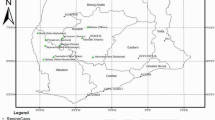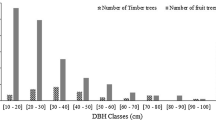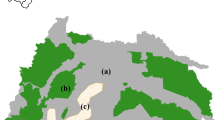Abstract
Agroforestry systems (AFS) are important agricultural land use in synergy with socio-environmental aspects, especially with cacao (Theobroma cacao L.) crop, a commodity mainly produced by smallholders in the humid tropics. In southern Pará, Brazilian Amazon, farmers manage native shade trees growing with cacao, but species selection may be not appropriate to AFS maintenance over time. The objective of this study was to understand the shade trees transition between successional management phases of cacao-AFS, considering its initial shade (IS) and secondary shade (SS). It was sampled 10 plots in each situation (20,000 m2 in total) identifying individuals with CBH ≥ 15 cm. As expected, floristic composition was different and SS had greater species richness and diversity than IS, where only 17% of species were the shared among them. Musa sp. and Carica papaya L. were found only in IS and were dominant species, representing almost a half of the individuals. Although there was increase of late succession species from IS to SS, this still keeps high abundance of early succession species, such as Cecropia sp. The result shows an unexploited potential products and gap of services provision, such as N-fixing. The conclusion highlights the necessity of long-term succession planning and management practices to guarantee cacao crop maintenance and improve diversification with other income sources, such as fruits and wood. The role of biodiversity conservation, provided by shade trees, should be the target of political strategies to encourage its maintenance, such as payment for ecosystems services or other economic incentives.







Similar content being viewed by others
References
Abou Rajab Y, Leuschner C, Barus H, Tjoa A, Hertel D (2016) Cacao cultivation under diverse shade tree cover allows high carbon storage and sequestration without yield losses. PLoS ONE 11(2):e0149949. https://doi.org/10.1371/journal.pone.0149949
Adou Yao CY, Kpangui KB, Koffi BJC, Vroh BTA (2015) Farming practices, diversity and utilizations of associated species of cocoa plantations in a forest savannah transition zone, Center Côte d’Ivoire. Glob J Wood Sci For Wildl 3(3):094–100
Asase A, Tetteh DA (2016) Tree diversity, carbon stocks, and soil nutrients in cocoa-dominated and mixed food crops agroforestry systems compared to natural forest in southeast Ghana. Agroecol Sustain Food 40:96–113
Bieng MAN, Gidoin C, Avelino J, Cilas C, Deheuvels O, Wery J (2013) Diversity and spatial clustering of shade trees affect cacao yield and pathogen pressure in Costa Rican agroforests. Basic Appl Ecol 14:329–336
Bos MM, Steffan-Dewenter I, Tscharntke T (2007) Shade tree management affects fruit abortion, insect pests and pathogens of cacao. Agr Ecosyst Environ 120:201–205
Carneiro VMC, Sablayrolles PJL, Oliveira CG, Sablayrolles MGP (2012) Floristic composition and diversity of forest remaining in lots of farmers of the Triunfo do Xingu Environmental Protection Area, Para, Brazil. Enciclopédia Biosfera, Centro Científico Conhecer 8:1783–1795
Cerda R, Deheuvels O, Calvache D, Niehaus L, Saenz Y, Kent J, Vilchez S, Villota A, Martinez C, Somarriba E (2014) Contribution of cocoa agroforestry systems to family income and domestic consumption: looking toward intensification. Agrofor Syst. https://doi.org/10.1007/s10457-014-9691-8
Clough Y, Faust H, Tscharntke T (2009) Cacao boom and bust: sustainability of agroforests and opportunities for biodiversity conservation. Conserv Lett 2:197–205
Clough Y, Barkmann J, Juhrbandt J, Kessler M, Cherico Wanger T, Anshary A, Buchori D, Cicuzza D, Darras K, Dwi Putra D, Erasmi S, Pitopang R, Schmidt C, Schulze CH, Seidel D, Steffan-Dewenter I, Stenchly K, Vidal S, Weist M, Wielgoss AC, Tscharntke T (2011) Combining high biodiversity with high yields in tropical agroforests. Proc Natl Acad Sci USA 108:8311–8316
Dechert G, Veldkamp E, Brumme R (2005) Are partial nutrient balances suitable to evaluate nutrient sutainability of land use systems? Results from a case study in Central Sulawesi, Indonesia. Nutr Cycl Agroecosyst 72:201–212
Deheuvels O, Avelino J, Somarriba E, Malezieux E (2012) Vegetation structure and productivity in cocoa-based agroforestry systems in Talamanca, Costa Rica. Agric Ecosyst Environ 149:181–188
Deheuvels O, Rousseau GX, Quiroga GS, Franco MD, Cerda R, Mendoza SJV, Somarriba E (2014) Biodiversity is affected by changes in management intensity of cocoa-based agroforests. Agrofor Syst. https://doi.org/10.1007/s10457-014-9710-9
Flora do Brasil 2020 (2014) Rio de Janeiro Botanical Garden. http://floradobrasil.jbrj.gov.br/. Accessed Apr 2014
Franzen M, Mulder MB (2007) Ecological, economic and social perspectives on cocoa production worldwide. Biodivers Conserv 16:3835–3849
Hartemink AE (2005) Nutrient stocks, nutrient cycling, and soil changes in cocoa ecosystems: a review. Adv Agron 86:227–253
Hooper DU (1998) The role of complementarity and competition in ecosystem responses to variation in plant diversity. Ecology 79(2):704–719
Instituto Brasileiro de Geografia e Estatística—IBGE (2002) Climate map of Brazil. http://www.ibge.gov.br/home/. Accessed 08 Aug 2014
Jagoret P, Michel-Dounias I, Malézieux E (2011) Long-term dynamics of cocoa agroforests: a case study in central Cameroon. Agrofor Syst 81:267–278
Jagoret P, Kwesseu J, Messie C, Michel-Dounias I, Malézieux E (2014) Farmers assessment of the use value of agrobiodiversity in complex cocoa agroforestry systems in central Cameroon. Agrofor Syst 88:983–1000
Jagoret P, Snoeck D, Bouambi E, Todem Ngnogue H, Nyassé S, Saj S (2017) Rehabilitation practices that shape cocoa agroforestry systems in Central Cameroon: key management strategies for long-term exploitation. Agrofor Syst. https://doi.org/10.1007/s10457-016-0055-4 (on line)
McNeely JA, Schroth G (2006) Agroforestry and biodiversity conservation—traditional practices, present dynamics, and lessons for the future. Biodivers Conserv 15:549–554
Ofori-Bah A, Asafu-Adjaye J (2011) Scope economies and technical efficiency of cocoa agroforesty systems in Ghana. Ecol Econ 70:1508–1518
Ribeiro RJ, Higuchi N, Santos J, Azevedo CP (1999) Estudo fitossociológico nas regiões de Carajás e Marabá—Pará, Brasil. Acta Amazon 29(2):207–222
Rice RA, Greenberg R (2000) Cacao cultivation and the conservation of biological diversity. Ambio 29(3):167–173
Saj S, Jagoret P, Todem Ngogue H (2013) Carbon storage and density dynamics of associated trees in three contrasting Theobroma cacao agroforests of Central Cameroon. Agrofor Syst 87(6):1309–1320. https://doi.org/10.1007/s10457-013-9639-4
Saj S, Durot C, Sakouma KM, Gamo KT, Avana-Tientcheu ML (2017) Contribution of associated trees to long-term species conservation, carbon storage and sustainability: a functional analysis of tree communities in cacao plantations of Central Cameroon. Int J Agric Sustain 15(3):282–302. https://doi.org/10.1080/14735903.2017.1311764
Salgado-Mora MG, Ibarra-Núñes G, Macías-Sámano JE, López-Baez O (2007) Diversidad arbórea en cacaotales del Soconusco, Chiapas, México. Interciencia 32(11):763–768
Salomão RP, Silva MFF, Rosa NA (1998) Inventário ecológico em floresta pluvial tropical de terá firme, serra norte, Carajás, Pará. Bol Mus Para Emilio Goeldi Ser Bot 4(1):1–46
Salomão et al. (2007) The forests of Belo Monte on the great curve of the Xingu River, Eastern Amazon. Bol Mus Para Emílio Goeldi 2(3):57–153
Sambuichi RHR, Haridasan M (2007) Recovery of species richness and conservation of native Atlantic forest trees in the cacao plantations of southern Bahia in Brazil. Biodivers Conserv 16:3681–3701
Santos SRM, Miranda IS, Tourinho MM (2004) Biomass estimation of agroforestry systems of the Juba river floodplain in Cametá, Pará. Acta Amazon 34(1):1–8
Schroth G, Krauss U, Gasparotto L, Duarte Aguilar JA, Vohland K (2000) Pests and diseases in agroforestry systems of the humid tropics. Agrofor Syst 50:199–241
Schroth G, Fonseca GAB, Harvey SA, Gascon C, Vasconcelos HL, Izac AMN (2004) Agroforestry and biodiversity conservation in tropical landscapes. Island Press, Whashington, p 537p
Schroth G, Garcia E, Griscom BW, Teixeira WG, Barros LP (2016) Commodity production as restoration driver in the Brazilian Amazon? Pasture re-agro-forestation with cocoa (Theobroma cacao) in southern Para. Sustain Sci 11:277–293
Silatsa FBT, Yemefack M, Ewane-Nonga N, Kemga A, Hanna R (2016) Modeling carbon stock dynamics under fallow and cocoa agroforest systems in the shifting agricultural landscape of Central Cameroon. Agrofor Syst. https://doi.org/10.1007/s10457-016-9973-4
Somarriba E, Beer J (2011) Productivity of Theobroma cacao agroforestry systems with timber or legume service shade trees. Agrofor Syst 81:109–121
Somarriba E, Beer J, Muschler RG (2001) Research methods for multistrata agroforestry systems with coffee and cacao: recommendations from two decades of research at CATIE. Agrofor Syst 53:195–203
Somarriba E, Cerda R, Orozco L, Cifuentes M, Dávila H, Espin T, Mavisoy H, Ávila G, Alvarado E, Poveda V, Astorga C, Say E, Degeuvels O (2013) Carbon stocks and cocoa yields in agroforestry systems of Central America. Agric Ecosyst Environ 173:46–57
Sonwa DJ, Weise SF, Schroth G, Janssens MJJ, Shapiro HY (2014) Plant diversity management in cocoa agroforestry systems in West and Central Africa—effects of markets and household needs. Agrofor Syst 88:1021–1034
Souza HN, Goede RGM, Brussard L, Cardoso IM, Duarte EMG, Fernandes RBA, Gomes LC, Pulleman MM (2012) Protective shade, tree diversity and soil properties in coffee agroforestry systems in the Atlantic Rainforest biome. Agric Ecosyst Environ 146:179–196
Specieslink (2014) Flora and fungi virtual herbarium. http://splink.cria.org.br/. Accessed Apr 2014
Sperber CF, Nakayama K, Valverde MJ, Neves FS (2004) Tree species richness and density affect parasitoid diversity in cacao agroforestry. Basic Appl Ecol 5:241–251
Thijs KW, Aerts R, Moortele P, Aben J, Musila W, Pellikka P, Gulinck H, Muys B (2015) Trees in a human-modified tropical landscape: species and trait composition and potential ecosystem services. Landsc Urban Plan 144:49–58
Tondoh JE, Kouamé FN, Guéi AM, Sey B, Koné AW, Gnessougou N (2015) Ecological changes induced by full-sun cocoa farming in Côte d’Ivoire. Glob Ecol Conserv 3:575–595
Tscharntke T, Clough Y, Bhagwat SA, Buchori D, Faust H, Hartel D, Holscher D, Juhrnbandt J, Kessler M, Perfecto I, Scherber C, Schroth G, Veldkamp E, Wanger T (2011) Multifunctional shade-tree management in tropical agroforestry landscapes—a review. J Appl Ecol 48:619–629
Useche P, Blare T (2013) Traditional vs. modern production systems: price and nonmarket considerations of cacao producers in Northern Ecuador. Ecol Econ 93:1–10
Utomo B, Prawoto AA, Bonnet S, Bangviwat A, Gheewala SH (2015) Environmental performance of cocoa production from monoculture and agroforestry systems in Indonesia. J Clean Prod. https://doi.org/10.1016/j.jclepro.2015.08.102
Vaast P, Somarriba E (2014) Trade-offs between crop intensification and ecosystem services: the role of agroforestry in cocoa cultivation. Agrofor Syst 88:947–956
Valencia V, Naeem S, Garcia-Barrios L, West P, Sterlin EJ (2016) Conservation of tree species of late succession and conservation concern in coffee agroforestry systems. Agric Ecosyst Environ 219:32–41
Vanhove W, Vanhoudt N, Damme PV (2016) Effect of shade tree planting and soil management on rehabilitation success of a 22-year-old degraded cocoa (Theobroma cacao L.) plantation. Agric Ecosyst Environ 219:14–25
Vebrova H, Lojka B, Husband TP, Zans MEC, Damme PV, Rollo A, Kalousova M (2014) Tree diversity in cacao agroforests in San Alejandro, Peruvian Amazon. Agrofor Syst 88:1101–1115
Acknowledgements
This research was supported by São Paulo Research Foundation - FAPESP (2012/25335-2) and field activities by Institute of Agricultural and Forest Management and Certification—Imaflora, specially Matheus Couto and Eduardo Trevisan. We would also like to thank Prof. Pedro H. S. Brancalion (for research orientations), Ricardo G. Cesar and Debora Rother (analysis suggestions), Silvio Marchini (manuscript review). Our gratitude goes to all farmers who cooperated.
Author information
Authors and Affiliations
Corresponding author
Rights and permissions
About this article
Cite this article
Braga, D.P.P., Domene, F. & Gandara, F.B. Shade trees composition and diversity in cacao agroforestry systems of southern Pará, Brazilian Amazon. Agroforest Syst 93, 1409–1421 (2019). https://doi.org/10.1007/s10457-018-0250-6
Received:
Accepted:
Published:
Issue Date:
DOI: https://doi.org/10.1007/s10457-018-0250-6




